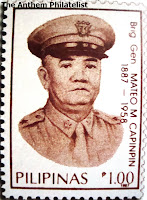Gregoria de Jesus on Stamps

Gregorio de Jesus was the first female member of the Katipunan. She was also the wife of Andres Bonifacio and took care of safekeeping all the necessary documents of the Katipunan and orienting new members of the movement. She also made the first Katipunan flag.
Gregoria de Jesús (15 May 1875 – 15 March 1943), also known as Aling Oriang,[1] was the founder and vice-president of the women's chapter of the Katipunan of the Philippines.[2] She was also the custodian of the documents and seal of the Katipunan. She married Andrés Bonifacio, the supremo of the Katipunan, and played a major role in the Philippine Revolution. She has one son from Andrés Bonifacio and five children from Julio Nakpil.
Gregoria de Jesús was born in the city of Caloocan, in what is now the province Rizal, to a Catholic middle-class family. Her father, Nicolás de Jesús, was a carpenter who later served as a gobernadorcillo. As a young girl, she was an exceptional student and a silver medal recipient in an examination organized by the governor general and parish priest. When she became a secondary school student, she was induced by her parents to stay home and look after her younger sister and the family's farm, since both of her older brothers moved to Manila to continue their education.
When Gregoria de Jesús was only 18 years old, Andrés Bonifacio fell in love with her and wanted to marry her. He revealed his intentions to her parents, but her father refused and was against their marriage because Andrés was a Freemason. After almost six months, she had fallen in love with him. She revealed that to her father and asked for his approval on their marriage and the father agreed.
In March 1893, she married Andrés at Binondo Church. A week later, they were married again in the presence of the Katipuneros, who did not approve of their marriage in a Catholic church. On the evening of the same day, the women’s chapter of the Katipunan was formed, and she was appointed its vice-president and the custodian of the Katipunan documents. She was designated the code name "Lakambini" (Tagalog for goddess or Muse) and swore to remain loyal to the Katipunan's holy purposes. The Spanish police usually came unannounced, and Gregoria used to gather all the documents and drive her car all night and return only when it is safe.
A year later, she returned to her family's house, because she was pregnant. She gave birth to their only son, who she christened Andrés, after her husband. Two months later, during the Holy Week of 1896, Gregoria and her husband returned to Manila to find their house destroyed by a fire. The couple were forced to live in friends' and family houses, but had to move quickly from house to house. A few months later, their child, Andrés, died of smallpox.
On 19 August 1896, the Katipunan was exposed and its secrets were revealed by Teodoro Patino, a disgruntled member. The Spanish forces reacted quickly to halt the revolution. Many Filipinos were arrested, jailed, and shot, but Andrés and Gregoria were hiding. The Spanish government was able to tighten its surveillance over the Katipunan. The remaining Katipuneros gathered and planned an attack on a Spanish gunpowder storehouse. With an army of almost 800, the Katipuneros were successful in their first attack, and were encouraged to advance to Manila, but Spanish reinforcements arrived, routing the Katipuneros. Hundreds of the Katipuneros were killed and captured. Furthermore, an inner conflict between Andrés and Emilio Aguinaldo, another leader of the Katipunan, had weakened them. On 8 May 1897, Andrés was captured by Aguinaldo's officers, and was sentenced to death.
Julio Nakpil, a commander of the Katipunan troops in northern Philippines. The two fell in love, and were married in a Catholic church on 10 December 1898 in Manila. After the end of the Philippine Revolution and after peace was restored in the Philippines, Gregoria lived with her husband and eight children in a house with a well-known Filipino philanthropist, Dr. Ariston Bautista, and his wife, Petrona Nakpil. The doctor took good care of her and her children and helped raise them and educate them.
De Jesús died in 1943 during the Japanese occupation of the Philippines.
The stamp was issued in March 28, 1978.






